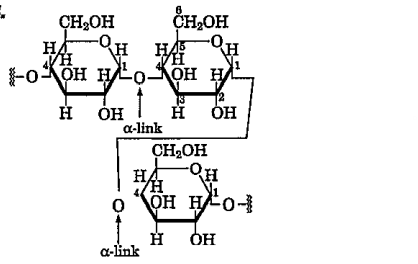In glycogen, the right end of the polysaccharide chain is called
Non - reducing end
C - terminal
Reducing end
N - terminal
The correct Answer is:C
To solve the question about the right end of the polysaccharide chain in glycogen, we can follow these steps:
1. Understanding Glycogen Structure:
- Glycogen is a polysaccharide made up of glucose units linked together by glycosidic bonds. It has a branched structure.
2. Identifying the Ends of the Polysaccharide Chain:
- In polysaccharides, there are two ends: one end has a free anomeric carbon (C1) and the other end is where the last glucose unit is attached via a glycosidic bond.
3. Determining the Right End:
- The right end of the glycogen chain is where the last glucose unit is attached, and it is important to note whether this end has a glycosidic bond or not.
4. Recognizing the Reducing and Non-reducing Ends:
- The end of the polysaccharide chain that has a free anomeric carbon (C1) is known as the reducing end. This is because it can participate in redox reactions.
- The other end, which is involved in a glycosidic bond, is referred to as the non-reducing end.
5. Conclusion:
- In glycogen, the right end of the polysaccharide chain is called the reducing end because it has a free anomeric carbon and does not have a glycosidic bond.
Final Answer:
The right end of the polysaccharide chain in glycogen is called the reducing end.
---
- Glycogen is a polysaccharide made up of glucose units linked together by glycosidic bonds. It has a branched structure.
- In polysaccharides, there are two ends: one end has a free anomeric carbon (C1) and the other end is where the last glucose unit is attached via a glycosidic bond.
- The right end of the glycogen chain is where the last glucose unit is attached, and it is important to note whether this end has a glycosidic bond or not.
- The end of the polysaccharide chain that has a free anomeric carbon (C1) is known as the reducing end. This is because it can participate in redox reactions.
- The other end, which is involved in a glycosidic bond, is referred to as the non-reducing end.
- In glycogen, the right end of the polysaccharide chain is called the reducing end because it has a free anomeric carbon and does not have a glycosidic bond.
The right end of the polysaccharide chain in glycogen is called the reducing end.
Topper's Solved these Questions
Similar Questions
Polysaccharides
View SolutionStudy the given statements and select the correct answer.
(i) Right end of a polysaccharide chain is called reducing end while left end is called non-reducing end.
(ii) Starch can hold cellulose being non-helical, cannot hold iodine.
(iii) Starch and glycogen are branched molecules. (iv) Starch and glycogen are the reserve food materials of plants and animals, respectively.
View Solution
Knowledge Check

The above polysaccharide is calledAamyloseBamylopectinCcelluloseDglycogenA glycogen is
Aa polysaccharide found in animalsBa polysaccharide found in plantsCa polysaccharide found in fruitsDan enzymeGlycogen is
ASynthesized in liver, source of energy,forming bile and lipaseBDisaccharide stored in liver, reacts with ammonia to form proteinCSynthesized in blood, stored in liver and muscles to provide glucoseDPolysaccharide synthesized and stored in liver
